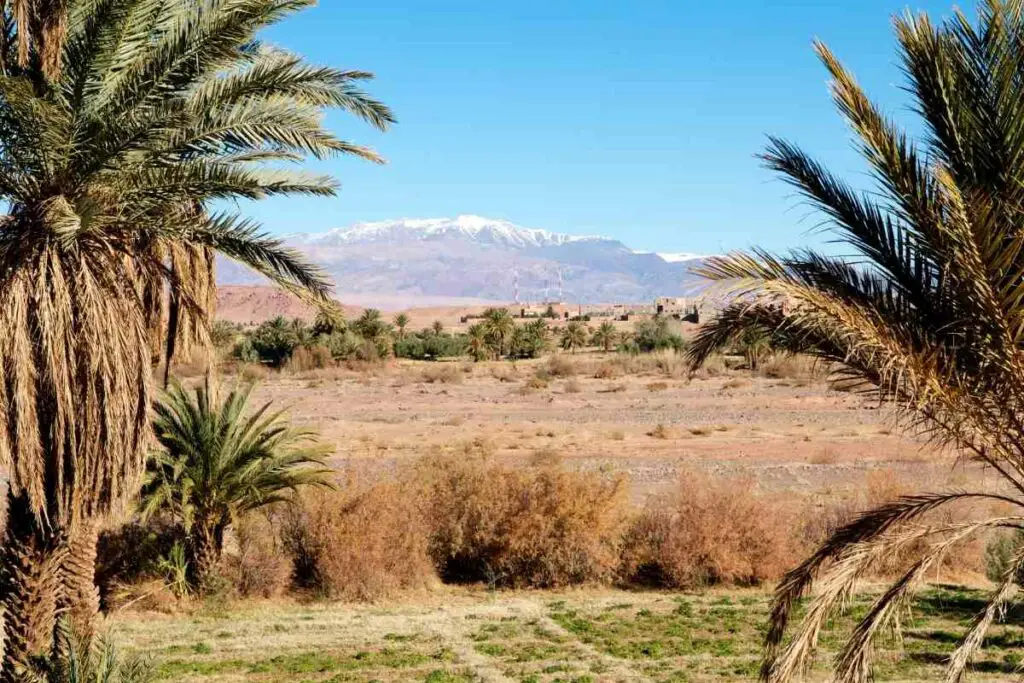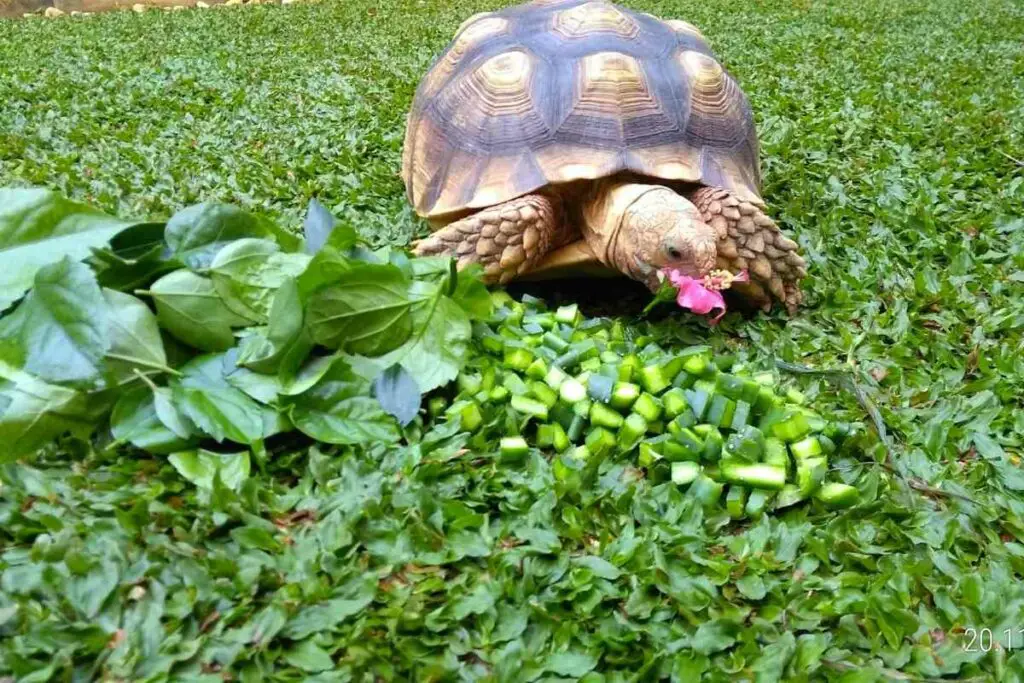Are you thinking of getting a Sulcata tortoise? These turtles start out small and become enormous, topping off at 79-100 pounds.
They are lively, beautiful creatures, with highly decorative scales and – for tortoises – lively personalities. Sulcata turtles spend much of their time grazing or patroling their enclosure.
They also enjoy (and require) a soak once or twice a week! So, what should you feed your Sulcata tortoise?

Any else you should know?
Learn more below!
Table of Contents
About the Sulcata Tortoise (Origin)
Sulculta tortoises are natives of the Sahara desert and Nothern Africa. They were adopted as pets because people were impressed by the general size of the tortoise (it weighs in at 79-100 pounds, making it one of the largest tortoise breeds in the world), as well as its looks and personality.
This is a large, beautifully-scaled tortoise that’s known for its curiosity. It also lives up to and even exceeds 100 years old; some serious longevity.
This makes them a pet you can enjoy life-long – as long as you care for them properly. Fortunately, it’s not too difficult to care for a Sulcata tortoise. Mostly, they need food, water, enough room, and a regular soak!
COMMON NAMES: Sulcata tortoise, African spurred tortoise
SCIENTIFIC NAME: Geochelone sulcata
ADULT SIZE: 18 to 30 inches long, weighing 80 to 150 pounds
LIFE EXPECTANCY: 70 years or more

What Should I Feed My Sulcata Tortoise?
Above all, Sulcata tortoises eat grass. In fact, this makes up 90% of their diet and is chock-full of fiber. Of course, only certain kinds of grass are suitable.
Along with this, you should always make sure that the grass is fresh and free of pesticide or other chemicals (such as fertilizer). Suitable grasses include rye, rice, alfalfa, Bermuda, and clover!

You can plant some of these grasses right in your tortoise enclosure, ideally. This will allow them to graze naturally. Just make sure to keep the edges of the enclosure clear, as Sulcatas like to patrol them.
This will ensure their walkway – and view – are clear!
What Can I Give My Sulcata Tortoise as a Snack?
For a healthy snack, you can grow chard, violets, geranium, nasturtium, cilantro, oregano, and basil. These are all fiber-rich and full of vitamins, making for quality grazing material.
What’s more, Sulcata tortoises can have 15% of their diet made up of veggies (as an occasional snack). The best choices of veggies for Sulculta tortoises are sweet potatoes, grated carrots, broccoli, corn on the cob, pumpkin, and winter squash.
For greens, they can have dandelions, collards, kale, and romaine. Just make sure that these don’t exceed 15% of their diet, or they could get sick.
Otherwise, any of these things can make a tasty and nutritious Sulcata tortoise snack!
How Often Should You Soak a Sulcata Tortoise?
Like many tortoises, to maintain their health, Sulcatas need an occasional soak in water. For the Sulcatas, just 1-2 a week for 15-30 minutes will do the trick.
How do you soak a Sulcata tortoise? Simply put them in a suitable container full of warm water. It should be shallow enough that their head will still stick out of the water!
While they’re hydrating, they’ll likely move around a little, and even drink a bit of the water.
How Can You Tell if Your Tortoise is Dehydrated?
Bathing is key to most tortoises’ survival. If a Sulcata tortoise goes too long without a soak, you’ll be able to tell. How? Take a look!
- Weight loss. When they don’t soak often enough, tortoises will love weight. This is because they are unhappy and dehydrated. They will lose interest in their food. Fortunately, usually, all that you need to do is soak them properly, and their appetite will come back!
- Lethargy. Is your tortoise a bit slower than usual? This could be a sign of dehydration. It could also be a sign of other illnesses, so keep an eye on the situation. Usually, a good bath should have them feeling livelier!
- Dry droppings. Among many animals, dry droppings are a sign of dehydration. The Sulcata tortoise is no exception. If you notice that your Sulcata tortoise’s droppings are looking drier, they could be late on a bath, and you may want to bathe them promptly.
- Dry, flaky skin. Another sign of dehydration in a tortoise is dry, flaky skin. This is one of the signs that your Sulcata tortoise is due for a soak!
- Loss of appetite. If your tortoise isn’t eating as it should and shows any of the other signs on this list, it’s likely because they are dehydrated. If you think dehydration is indeed the culprit, make sure to give them a prompt, proper soak!
Make Sure Your Sulcata Tortoise Has Plenty of Drinking Water
Along with its weekly soak, your Sulcata tortoise should have drinking water available daily. This should be in big clay saucers or on baking pans, either will work! Make sure to refresh the water occasionally, so it’s clean and clear.
Where Should I Keep My Sulcata Tortoise?
In general, the best place for a Sulcata tortoise is outdoors. This will ensure that they have enough space to roam. Usually, a setup with grass and dirt is ideal.
To keep a Sulcata tortoise outside successfully, the temperature in your location should not drop below the mid-50s. Otherwise, it can get too chilly for these desert-dwelling creatures.
There should also be shade available on particularly hot days; if the temperature exceeds 85 F, your Sulcata could begin to overheat and dehydrate, otherwise.
With a Sulcata tortoise, you will want to remember to give the temperature a double check!
Shade is Important
In the wild, Sulcata Tortoises rely on shade when it gets too hot out. This means that your Sulcata pen will need a few deeply-shaded spots.
These can be created with bushes, soft sediment for them to dig into, and maybe some tall rocks to provide shade perpetually.
This will help make sure that your Sulcata doesn’t overheat, and that they’re comfortable and happy. Of course, most of the time, Sulcatas enjoy the warmth, but even desert-borne tortoises need to cool off.
Do Sulcata Tortoises Make Good Pets?
Sulcata tortoises are known to be quite sociable, and will definitely hang out with their owners/observe them from afar.
They are said to be good at recognizing people (at least, as far as tortoises go). What’s more, they require particular but simple care.
So, it really depends on if you have room for their spacious 80-foot enclosure in your backyard, and if you’re ready to give your Sulcata a weekly soak!
How Much Room Does a Sulcata Tortoise Need?
So, how much room will a Sulcata Tortoise need? Roughly 80-feet should work. This will ensure that your curious and lively (as far as tortoises go) tortoise will have room to graze, explore, and exercise.

This will help keep them in good health, physically, and mentally. If you want to keep your Sulcata tortoise indoors, it will need similar warmth and a UVB light during the day.
During the night, they prefer it to be cool (still not below the mid-50-s) and dark. It’s also still recommended that you have your Sulcata (if the temperature is right) outside for at least part of the year.
This will make them happier and healthier!
How Long Until a Sulcata Tortoise Is Fully Grown?
So, when will you know that your Sulcata tortoise is fully grown? These tortoises reach maturity at roughly 15-20 years old.
This is typically when their growth will slow, although they can always get a bit larger!
So, if you’re thinking of getting a Sulcata tortoise, here’s everything you need to know. That is, what to feed them, where and how they should live, suitable snacks, and a soak 1-2 times weekly.
These are beautiful tortoises that can make highly-rewarding pets. The Sulcata is even said to be able to recognize their owners, and they live 100+ years.
Just make sure they don’t dry out (by keeping up on the soaks/baths, twice a week, and providing fresh drinking water) and that they have plenty of shade.
Also, ensure that the temperature doesn’t drop below the mid-50s. Best of luck!




